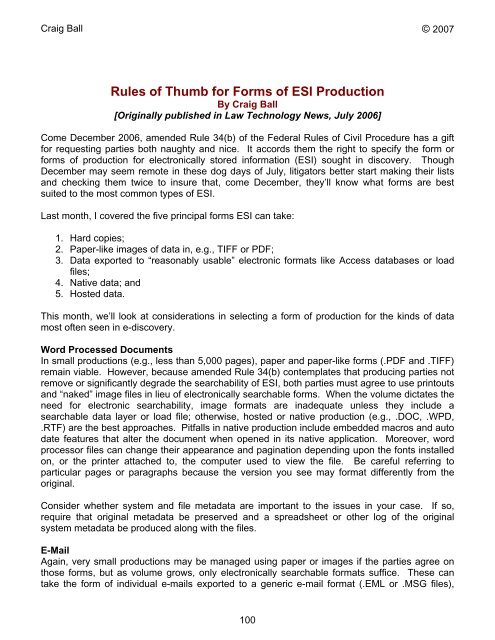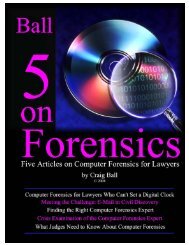Six Articles on Electronic - Craig Ball
Six Articles on Electronic - Craig Ball
Six Articles on Electronic - Craig Ball
Create successful ePaper yourself
Turn your PDF publications into a flip-book with our unique Google optimized e-Paper software.
<strong>Craig</strong> <strong>Ball</strong> © 2007<br />
Rules of Thumb for Forms of ESI Producti<strong>on</strong><br />
By <strong>Craig</strong> <strong>Ball</strong><br />
[Originally published in Law Technology News, July 2006]<br />
Come December 2006, amended Rule 34(b) of the Federal Rules of Civil Procedure has a gift<br />
for requesting parties both naughty and nice. It accords them the right to specify the form or<br />
forms of producti<strong>on</strong> for electr<strong>on</strong>ically stored informati<strong>on</strong> (ESI) sought in discovery. Though<br />
December may seem remote in these dog days of July, litigators better start making their lists<br />
and checking them twice to insure that, come December, they’ll know what forms are best<br />
suited to the most comm<strong>on</strong> types of ESI.<br />
Last m<strong>on</strong>th, I covered the five principal forms ESI can take:<br />
1. Hard copies;<br />
2. Paper-like images of data in, e.g., TIFF or PDF;<br />
3. Data exported to “reas<strong>on</strong>ably usable” electr<strong>on</strong>ic formats like Access databases or load<br />
files;<br />
4. Native data; and<br />
5. Hosted data.<br />
This m<strong>on</strong>th, we’ll look at c<strong>on</strong>siderati<strong>on</strong>s in selecting a form of producti<strong>on</strong> for the kinds of data<br />
most often seen in e-discovery.<br />
Word Processed Documents<br />
In small producti<strong>on</strong>s (e.g., less than 5,000 pages), paper and paper-like forms (.PDF and .TIFF)<br />
remain viable. However, because amended Rule 34(b) c<strong>on</strong>templates that producing parties not<br />
remove or significantly degrade the searchability of ESI, both parties must agree to use printouts<br />
and “naked” image files in lieu of electr<strong>on</strong>ically searchable forms. When the volume dictates the<br />
need for electr<strong>on</strong>ic searchability, image formats are inadequate unless they include a<br />
searchable data layer or load file; otherwise, hosted or native producti<strong>on</strong> (e.g., .DOC, .WPD,<br />
.RTF) are the best approaches. Pitfalls in native producti<strong>on</strong> include embedded macros and auto<br />
date features that alter the document when opened in its native applicati<strong>on</strong>. Moreover, word<br />
processor files can change their appearance and paginati<strong>on</strong> depending up<strong>on</strong> the f<strong>on</strong>ts installed<br />
<strong>on</strong>, or the printer attached to, the computer used to view the file. Be careful referring to<br />
particular pages or paragraphs because the versi<strong>on</strong> you see may format differently from the<br />
original.<br />
C<strong>on</strong>sider whether system and file metadata are important to the issues in your case. If so,<br />
require that original metadata be preserved and a spreadsheet or other log of the original<br />
system metadata be produced al<strong>on</strong>g with the files.<br />
E-Mail<br />
Again, very small producti<strong>on</strong>s may be managed using paper or images if the parties agree <strong>on</strong><br />
those forms, but as volume grows, <strong>on</strong>ly electr<strong>on</strong>ically searchable formats suffice. These can<br />
take the form of individual e-mails exported to a generic e-mail format (.EML or .MSG files),<br />
100













